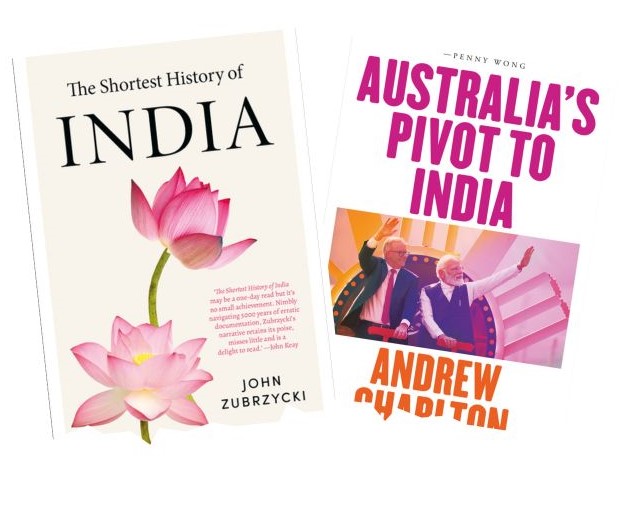The Shortest History of India, by John Zubrzycki. (Black Inc, 2022)
Australia’s Pivot to India, by Andrew Charlton (Black Inc, 2023)
With their compact coverage of broad subjects, these two books demonstrate the value of concision and compression.
Andrew Charlton reviews succinctly the full gamut of Australia’s relations with India, focusing especially on “four D’s”: democracy, defence, dosti (or friendship) and the diaspora. For his part, John Zubrzycki appraises India’s “convoluted and increasingly contested” history, treating the country as “both an idea and an entity”.
Charlton is distinctly positive about India in “its present incarnation as emerging superpower”. He even concludes that “we may well end the 21st century with India on top”. Given this estimation of India’s prospects, Charlton urges Australia to go beyond “transactional engagement and circumstantial alignment” with the sub-continent. Past failures in “unfulfilled promises and unrealised aspirations” need to be replaced with a purposeful commitment to India.
As befits his training and experience as both an economist and a politician, Charlton is particularly strong on India’s economic structure and potential. Manmohan Singh is rightly praised for eradicating the crippling constraints of the License Raj and the “Hindu rate of growth”. In addition, Charlton includes well-researched examinations of matters like faith and culture. He examines in detail the diaspora as a “human bridge” between India and Australia. Here, as anywhere else in the world, any match for the Indian cricket side is a home game.

If, however, Australia’s relations with India are to amount to more than false dawns and first dates, Australians will have to do more to learn about a subtle, ancient civilisation – perhaps rather more than we have done with Japan and China. The diaspora in Australia will need to start flexing its political muscle. Superannuation funds will have to re-assess further their judgments about risk with Indian investments. Policy makers in Canberra will be obliged to understand that India’s calculations and calibrations about China will necessarily diverge from our own.
Zubrzycki is as alert as Charlton to the challenges of dealing with India. His final chapter, “A New India?”, is a memorably brisk, crisp account of the economic and social problems confronting India. Zubrzycki worries about how India might improve health services, provide decent care for workers in the informal sector, create enough jobs, protect secularism and press freedom, and plan its swelling cities better. He notes the “risk of mass unrest” in resistance to economic reform, and thinks that further conflict over Kashmir “seems inevitable”.
Zubrzycki maintains that “the burden of history weighs heavily on (India’s) politics and society”. He explains the origins and contours of that burden in a remarkably cogent, coherent way, given that India may qualify as “the world’s oldest civilisation”.
Zubrzycki’s “shortest” history is understated, judicious, considered and fair. “Fair” in this context does not connote milquetoast or superficial. Along the way, Zubrzycki does allow space for some wonderful detail: excrement like parched bile; camel-mounted rockets; rolling elephants down mountainsides; a collection of 80,000 bird skins and nests (assembled by the founder of the Indian National Congress); the intricacies of the Lord of the Beats seal; and the length of the Mahabaratha (ten times that of Homer).
Those asides are consistently droll. They also all make a point. More importantly, Zubrzycki provides a thoughtful estimate of “the Magnificent Mughals”, a period of Indian history now too often weaponised. Shivaji and the Rani of Jhansi may have deserved more attention, but Zubrzycki is a thoroughly reliable guide to the incidents and personalities who matter most in the chronicle of India. Neither Clive nor Gandhi escapes censure. Throughout Zubrzycki keeps asking himself why events did not turn out differently. Why did the locals not resist Islamic expansion more effectively, or why was the First War of Independence concentrated in India’s North?
Although India inspires far too much mawkish sentimentality in the West, those who run the country are not sentimental folk. Indians may spend too much money on weddings and too much time at the flicks, but they will nonetheless form a hard-headed – and sometimes hard-edged – view about the value of relations with other countries.
For Australia to complete a pivot rather than a pirouette, our own version of tough thinking (and tough love for India) may be required.

